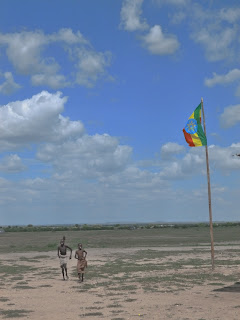 |
| Not the most formidable border |
 |
| Disadvantages of crossing borders off road: sometimes you reach a dead end / lake |
Unfortunately, for all of Namibia's wildness it does maintain a deep love of paperwork, and we had to get a foreigners driving permit, which is apparently only available from Windhoek, on a Tuesday, under a fair wind. Fearing the police would fine us without it, we dutifully headed in the other direction (hadn't seen a policeman in a while!)
Our destination was the incredible Etosha National Park - our last proper safari of the trip. If you google photos of Etosha, you will find some unbelievable photos of the watering holes there, which look like the queue for Noah's ark. The reason for this, is the dryness of the surround areas - there is no water for dozens of miles around, so any watering hole becomes an animal Mecca. Unfortunately, as we drove into the park, the heavens opened (good news for Namibia, which was in the middle of long drought, bad news for us) - and suddenly there were plenty of puddles for the animals to drinks from everywhere.
As a result the animal viewing was sparse but we had only one thing in mind. We'd seen plenty of the other big 5 animals on our trip, but were missing a rhino. Etosha is famous for Rhinos, so we thought we had a good chance. On the first morning we drove around the various watering holes and saw very little. We eventually turned on to one of the rougher tracks, more to kill time than anything, and after a while approached a pool on the left with two very large shapes in it. RHINO! An amazing sight, given how solitary they usually are. It was unclear whether one of them was quite keen on the other, or wanted a fight, but after a while it gave up either way and disappeared into the bushes. Something must have been in the air, because later on we saw a bit of Giraffe loving too (a bit light the fight on the BBC series Africa, but a with lot gentler neck action!)
 |
| Fighting / loving Rhino |
 |
| Canoodling Giraffe |
 |
| Getting going with the Braii routine |
 |
| Chilling out on Safari, watching the Rhino |
After travelling with some Saffas earlier in our trip, and talking A LOT about the South African obsession with the Braii, we thought it was about time we got into it, and Etosha marked the beginning of our nightly bbq routine for most of the rest of the trip. I was doing a mean Boerewors by the time we got to the Cape!
We then made a fleeting trip to Windhoek to pick up our papers (we did get stopped by the police in the end, but Anna charmed her way out of a ticket!), and were quickly off to the very german coastal down on Swakopmund.
The car needed some running repairs, so we had a hang around a couple of days on the coast. Fortunately, a friend of a friend, Henry, is a geologist working in the dessert just outside Swakop, and became our excellent host for the weekend! After showing us the sights and sounds of this small town, and introducing us to crazy drillers, and even more crazy local farmers alike, we felt like we had gotten a pretty good feel for the town. We even managed to find somewhere to watch the rugby again - was 3 for 3 on the six nations games, despite being on the road.
 |
| Killing time by the beach in Swakopmund |
After a couple of days static, we were keen to be on the road again, and out of Swakop, we were quickly off the tarmac, and on to the gravel road (it would be a good 600km until we say tar again). I love getting off the tar a bit, but this really wasn't as fun as elsewhere - the roads were dead straight, there was noone around, and it's all too easy to let your speed get away from you, and start sliding around on the gravel. It was also chewing up my expensive tyres.
Fortunately, my tyres were in better nick that than a car we found about an hour out of Walvis Bay. It was a young German couple who hired a car in Windhoek with rubbish tyres, and had a blow out. We were starting to make a habit of being a roadside rescue team, and I think they were truly shocked when we turned up from nowhere, changed the tyre for them in 10 mins, and then got them on their way. They looked in dispair when we arrived. It was just the kind of thing to lift your spirits before a long drive. We were heading south into the cauldron of South Namibia - things were about to get very hot!
























































